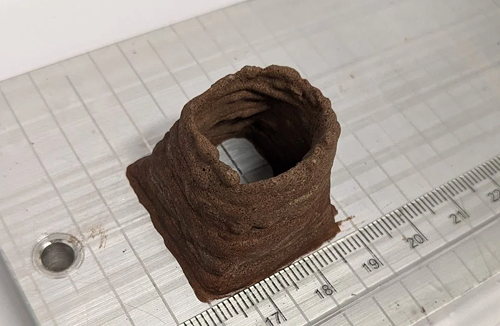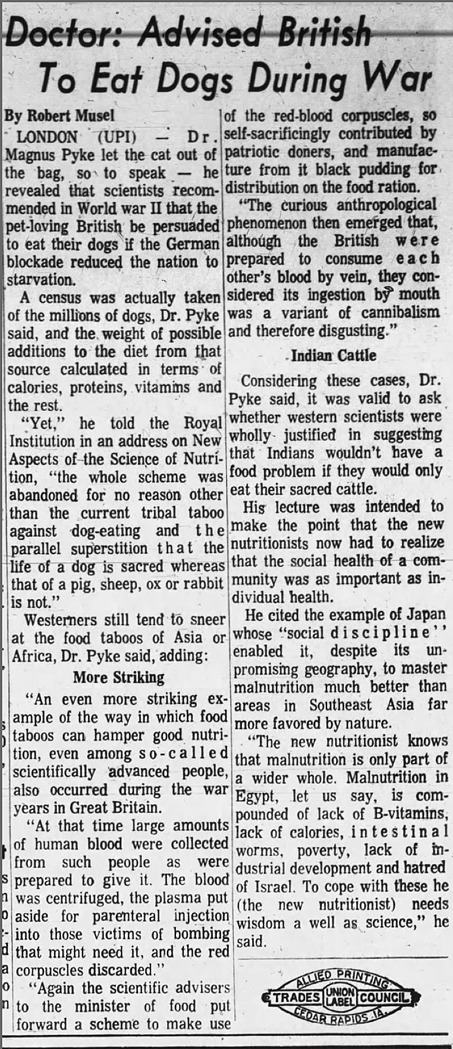Blood
Color photographs to fight crime
Use color film so you can see the blood better.
Posted By: Alex - Wed Nov 16, 2022 -
Comments (1)
Category: Photography and Photographers, Advertising, 1950s, Blood
The Blood Book by John Bingley Garland
Read the fully story here, with all the illos.
Posted By: Paul - Wed Sep 28, 2022 -
Comments (1)
Category: Eccentrics, Outsider Art, Books, Nineteenth Century, Blood
Period Crunch
I doubt you'll be able to buy this new cereal at your local grocery store anytime soon. It's raspberry-flavored, uterus-shaped, and turns the milk red when poured into the bowl.It's the creation of health brand Intimina who are hoping to "fight the stigma around menstruation." They note that 77% of the people they surveyed had "never talked about anything to do with menstruation at the place where the whole household regularly sits down and talks together: the kitchen table." This cereal aims to change that.
More info: Intimina.com

Posted By: Alex - Tue Jun 07, 2022 -
Comments (4)
Category: Cereal, Body Fluids, Blood
Martian Blood Concrete
Researchers at the University of Manchester have proposed that future settlers on Mars can create concrete by mixing Martian dust with their own blood and urine. Details from globalnews.ca:The blood-and-dust mixture alone is equivalent to concrete, but researchers say it becomes even stronger when human urea is added to the mix...
Roberts and his team say that animal blood could eventually replace human blood in Martian construction projects, but that would only happen after we send cows to Mars.

Experimental 'astrocrete' made from blood and dust
We've posted before about the use of blood to make concrete. Charles Laleman was granted a patent for this in 1980, but the practice goes all the way back to Roman times.
Posted By: Alex - Sat Oct 02, 2021 -
Comments (0)
Category: Architecture, Patents, Space Travel, Blood
Vamp puffer
Designer xalamander is selling a "Vamp puffer" that's "stitched with intricate muscle detailing." Price tag: $660.00.

Posted By: Alex - Tue Jul 20, 2021 -
Comments (0)
Category: Body, Blood, Fashion
Human Blood Pudding
Dr. Magnus Pyke was a scientific advisor to the British Ministry of Food during World War II. In 1969, during a lecture at the Royal Institution in London, he revealed the following:At that time large amounts of human blood were collected from such people as were prepared to give it. The blood was centrifuged, the plasma put aside for parenteral injection into those victims of bombing that might need it, and the red corpuscles discarded.
Again the scientific advisers to the minister of food put forward a scheme to make use of the red-blood corpuscles, so self-sacrificingly contributed by patriotic donors, and manufacture from it black pudding for distribution on the food ration.
The curious anthropological phenomenon then emerged that although the British were prepared to consume each other's blood by vein, they considred its ingestion by mouth was a variant of cannibalism and therefore disgusting.
They could have called it Soylent Black.

The Cedar Rapids Gazette - Dec 18, 1969
Posted By: Alex - Wed Oct 07, 2020 -
Comments (3)
Category: Cannibalism, Food, 1940s, Blood
The use of blood to make concrete

In 1980, Charles Laleman of France received a US patent (No. 4,203,674) for a technique for making concrete by mixing together cement with blood. His patent described a variety of different recipes one could use to create this blood concrete. For instance:
A light colloidal concrete is prepared by using:
a commercially available cement (cement CPA 400), a silico-calcareous sand graded no higher than 0.8 mm (the cement/sand mass ratio being equal to 1), whole blood powder of animal origin, a colloid, and mixing water in variable proportions.
The various constituents are mixed by means of a mixer working between 100 and 600 r.p.m.

The advantage of using blood, Laleman argued, was that the oxygen in it produced a lighter concrete.
Curiously, Laleman acknowledged that the idea of using blood to make concrete wasn't in any way new. He cited a variety of earlier patents, such as US patent 1,020,325 from 1912 which described mixing blood into concrete. And, in fact, the technique of using blood to make concrete was even practiced by the ancient Romans.
What made Laleman's technique unique (and therefore patentable) was apparently that he used it specifically to lighten the concrete, rather than to color it or to make it more porous. That seems like a rather fine distinction to me, but it was enough to earn him a patent.
Laleman's list of earlier patents includes another oddity. He refers to US Patent No. 3,536,507 (from 1970) which describes making concrete by combining cement with "an admixture which is derived from the fermentation liquor resulting from the aerobic fermentation of liquid carbohydrates, e.g., molasses from beet or cane sugar, corn, wheat or wood pulp." That sounds like a fancy way of saying they were mixing cement with beer.
Posted By: Alex - Sun Mar 15, 2020 -
Comments (4)
Category: Engineering and Construction, Inventions, Patents, 1980s, Blood
Just Can’t Put My Finger On It
Who knew this was a technique? See a more recent incident after the first story.DOCTOR MAKES A DRAMATIC RESCUE
Karen Dillon
CHICAGO TRIBUNE
Dr. Wendy Marshall was jolted awake at 5 a.m. by an urgent phone message: Doctors at a Joliet hospital were using nothing but their fingers to plug two bullet holes in a man`s heart in a last-ditch effort to save his life.
The doctors at Silver Cross Hospital ''said they had their fingers in the holes and couldn`t stop the bleeding,'' Marshall recounted Thursday.
In an age when sophisticated medical equipment can keep patients alive for months, this most basic technique ultimately saved the life of Tommy Lee
''Tony'' Hairston, of Joliet.
Before the night was over, Marshall, a cardiac surgeon and director of the Loyola University Medical Center`s Trauma Center and the Air Medical Service, would be flown to Joliet and use her own fingers to dike the holes. At the same time, Marshall squeezed the 29-year-old man`s heart to force it to pump when it stopped three times for a total of eight minutes.
Eventually, Hairston was taken by helicopter to Loyola where open heart surgery was performed. Thursday night he was listed in critical condition, but was expected to recover.
The drama began Wednesday night when Hairston, a landscaper shot after an argument with a neighbor over missing property, was taken to Silver Cross Hospital in Joliet.
Silver Cross physicians immediately operated on Hairston, but did not open up the victim`s heart. ''The surgeon found blood in the chest and a couple holes around the heart. At that time, he didn`t open up the heart,''
said Dr. Robert Freeark, chief of surgery at Loyola.
But then after surgery, Hairston started bleeding again. ''This time the surgeon opened Hairston up and and found two holes in his heart . . . and he couldn`t stop the bleeding,'' Freeark said.
The physicians did the only thing they could-stick their fingers into the holes in Hairston`s heart.
Marshall arose, dressed and was taken by helicopter to Silver Cross, accompanied by a paramedic, Kent Adams, and Laurie Dudek, a flight nurse. They arrived 23 minutes after the call.
At Silver Cross, Marshall found a hole in the front of the heart and one in the back. The location of the one in the back was in an area where it couldn`t be repaired without stopping the heart, she said, and Silver Cross didn`t have the equipment for such specialized treatment.
So it meant transporting Hairston to Loyola Medical Center-with Marshall`s fingers in the holes.
Before the night was over, Marshall, as her fingers plugged the holes, squeezed Hairston`s heart to force it to pump when it stopped three times for a total of eight minutes.
Marshall said she used the first two fingers of her right hand to plug the back hole and her right thumb to stop up the front hole. ''When the heart stopped, I kept my fingers in the holes and squeezed my left hand against the right.''
During the flight, Adams, the paramedic, forced Hairston to breathe by squeezing a bag attached to a tube that was shoved down his trachea.
Four intravenous tubes were attached to Hairston, feeding medicine to stimulate his heart beat-one into a large vein near his left collar bone, two to his left arm and one in his right arm.
When the team finally arrived at Loyola, cardiac surgeon Henry Sullivan had been alerted. The patient was placed on a machine that circulated his blood while the heartbeat was halted and the organ repaired, Freeark said.
Adams shook his head in wonder Thursday afternoon. ''It was dramatic,''
he said.
Adams said Marshall was steady as a rock during the flight. ''She was so calm. She just let us know what was happening, and then we did our part.''
Hairston allegedly was shot by Robert Knox, of Joliet, after an argument over some items reported missing from Hairston`s apartment, Joliet police said. Knox was charged with attempted murder, armed violence and unlawful use of a weapon, police said.
By Thursday afternoon, Hairston had awakened a few times, which is considered a positive sign, Marshall said.
Hairston ''is lucky to be alive today,'' she said. ''When the heart stops, most people are basically brain dead within three to four minutes.''
Freeark and another Loyola heart physician, Dr. Bruce Lewis, said that saving Hairston`s life by plugging the holes in his heart was amazing.
''To my knowlege it was totally unprecedented,'' Freeark said. ''Nobody has ever been transferred with a finger better.''
''Very, very amazing, and very rare to see someone survive after that . . . especially with the size of the hole (in the back of the heart),'' Lewis said.
Marshall took the praise in stride. ''Anyone who has got a blood pressure can be saved. So you go for it.''
Source.
Heroic military veterans and police officers put their training to use during the deadly mass shooting at a Las Vegas music concert — even “plugging bullet holes with their fingers,” according to a report.
“You saw a lot of ex-military just jump into gear,” witness Russell Bleck told the “Today” show on NBC. “I saw guys plugging bullet holes with their fingers.”
“While everyone else was crouching, police officers (were) standing up at targets, just trying to direct people, tell them where to go,” he added. “The amount of bravery I saw there, words can’t describe what it was like.”
The practice of plugging gunshot wounds helps to kick in the body’s defense mechanisms that prevent rapid blood loss, according to a Wired report.
Severe wounds, especially on the carotid arteries of the neck, must be quickly plugged with the fingers or packed to temporarily stop the hemorrhaging, according to Gould and Pyle’s Pocket Cyclopedia of Medicine and Surgery.
Source.
Posted By: Paul - Mon Mar 09, 2020 -
Comments (2)
Category: Body, Blood, Death, Guns, Medicine, Superheroes, 1980s, Twenty-first Century
Downunder Lipstick Glue
Glue for the lips "downunder."More info: NY Post, Forbes, Patent Office

Posted By: Alex - Thu Feb 23, 2017 -
Comments (2)
Category: Hygiene, Body Fluids, Patents, Blood, Genitals
Land of the Heads
Land of the Heads, Claude Barras & Cédric Louis, National Film Board of Canada
Posted By: Paul - Mon Oct 31, 2016 -
Comments (0)
Category: Holidays, Horror, Blood, Head, Fictional Monsters

| Who We Are |
|---|
| Alex Boese Alex is the creator and curator of the Museum of Hoaxes. He's also the author of various weird, non-fiction, science-themed books such as Elephants on Acid and Psychedelic Apes. Paul Di Filippo Paul has been paid to put weird ideas into fictional form for over thirty years, in his career as a noted science fiction writer. He has recently begun blogging on many curious topics with three fellow writers at The Inferior 4+1. Contact Us |




